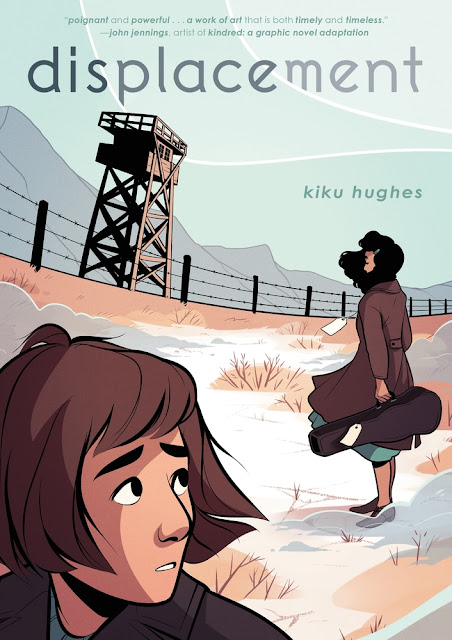DIsplacement by Kiku Hughes,
displacement by Kiku Hughes
Review Copy from FirstSecond
"Our connection to the past is not lost, even if we don't have all the documents, even if we never learn the details. The memories of community experiences stay with us and continue to affect our lives. . . Memories are powerful things."
Coming at the end of Hughes's debut graphic novel, this quote encompasses one of the main themes of her semi-autobiographical story and is a powerful reminder of how to move forward without allowing history to repeat itself.
Visiting San Francisco in the summer of 2016, sixteen-year-old Kiku and her mother are looking for the childhood home of a grandmother Kiku never knew - in fact, she doesn't even know her grandmother's first name at the start of the novel - when a fog overcomes her and she travels back in time. It's 1943 and Kiku finds herself standing alongside her teenaged grandmother and hundreds of other Japanese Americans being sent to a forced relocation camp. Struggling to adapt to her surroundings, Kiku, who is Japanese and white, is forced to realize that she knows little about her family's history and culture, commenting that, "in time travel movies, the person from the future is supposed to know what's going to happen. But I really didn't have a much of a clue."
Kiku's lack of knowledge of this passage of American history to allows readers the immediacy of experiencing the "difficult, degrading, terrifying" act of being a prisoner in a forced relocation camp right alongside her. Kiku's lack of knowledge of her family's history highlights the dual challenge of passing on memories of traumatic experiences and suppressing one culture, language and traditions in order not to appear "too Japanese" when the forced relocation ended. While Kiku's experience at Tanforan (a horse racing track that was used as an "assembly center" where prisoners were processed for forced relocation) and the Topaz War Relocation Center are bleak, Hughes also lifts up the better aspects of humanity. When Mr. Matsuzawa, an older, quiet neighbor at Tanforan, gives Kiku and other prisoners homemade gifts, she is moved by this unexpected gesture, especially when she realizes that the "small violin figure wth my grandmother's name on it [that] has been carefully tucked away in my family's living room my whole life" was also made by Mr. Matsuzawa. Kiku also makes connections and finds solace at camp, from her older, wiser, activist roommate to May, a classmate Kiko shares a kiss with. Returning to her own time and hoping to learn more about her family and those who befriended her at camp, Kiku finds an obituary for Masako "May" Ide, survived by her partner, Alice King.
Time travel allows Hughes to connect events of the past to those of the present where President Trump and advisors like Stephen Miller are spreading racist rhetoric and enacting executive orders aimed at persecuting immigrants that will "protect" our country. Kiku finds the courage to share her strange experience with her mother, who herself experienced "displacement." Together, mother and daughter research their family's past and the politics of the time, as well as the politics of the time they are living in, making connections for readers between the forced relocation camps and the forced separation of families at the border and on American soil. This research leads Kiku and her family to social activism, panels showing them with signs that read, "Abolish ICE Families Belong Together," and "Nikkei Support Latinx and Muslim Communities," word bubbles for both declaring, "Never Again."
Hughes shares personal photos and additional information in the back matter that add to this unforgettable, important novel.








